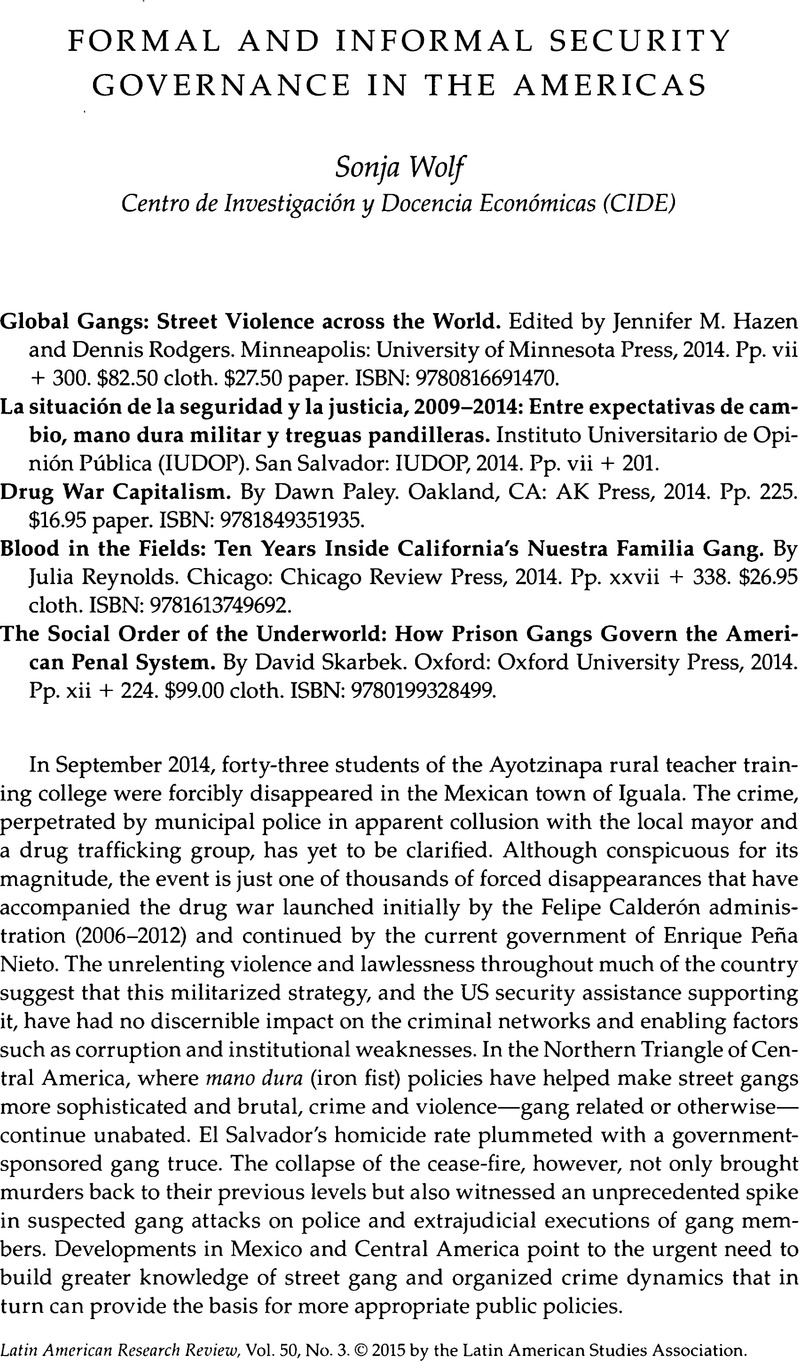Published online by Cambridge University Press: 05 September 2022

1. Carlos Silva Forné, Catalina Pérez Correa, and Rodrigo Gutiérrez Rivas, “Uso de la fuerza letal: Muertos, heridos y detenidos en enfrentamientos de las fuerzas federales con presuntos miembros de la delincuencia organizada,” Desacatos 40 (2012): 47–64; Catherine Daly, Kimberly Heinle, and David Shirk, Armed with Impunity: Curbing Military Human Rights Abuses in Mexico (San Diego, CA: Trans-Border Institute, 2012); Antonio Mazzitelli, “Influencia de los cárteles mexicanos en Centroamérica,” in Atlas de la seguridad y la defensa de México 2012, ed. Sergio Aguayo Quezada and Raúl Benítez Manaut (Mexico City: Colectivo de Análisis de la Seguridad con Democracia, 2012), 15–24.
2. Daniel Mejía and Pascual Restrepo, “The War on Illegal Drug Production and Trafficking: An Economic Evaluation of Plan Colombia,” Working Paper 2008–19, Centro de Estudios sobre Desarrollo Económico (Bogotá: Universidad de los Andes, 2008); Sabrina Abu-Hamdeh, “The Mérida Initiative: An Effective Way of Reducing Violence in Mexico?” Pepperdine Policy Review 4 (2011): 37–54; Eric Olson, ed., Crime and Violence in Central America's Northern Triangle: How U.S. Policy Responses Are Helping, Hurting, and Can Be Improved (Washington, DC: Woodrow Wilson Center, 2015).
3. Thomas Bruneau, Lucía Dammert, and Elizabeth Skinner, eds., Maras: Gang Violence and Security in Central America (Austin: University of Texas Press, 2011); Sonja Wolf, “El nexo entre las maras y el crimen organizado,” in Anuario 2012 de la seguridad regional en América Latina y el Caribe, ed. Hans Mathieu and Catalina Niño Guarnizo (Bogotá: Friedrich Ebert Foundation, 2012), 252–274; T. W. Ward, Gangsters without Borders: An Ethnography of a Salvadoran Street Gang (New York: Oxford University Press, 2013).
4. María Santacruz and Elin Ranum, “Seconds in the Air”: Women Gang-Members and Their Prisons (San Salvador: IUDOP, 2010); Lirio Gutiérrez Rivera, Territories of Violence: State, Marginal Youth, and Public Security in Honduras (New York: Palgrave Macmillan, 2013).
5. Carolina Sampó and Mariano Bartolomé, “Reflexiones sobre el cumplimiento de la tregua entre maras en El Salvador,” Estudios Internacionales (Universidad de Chile) 177 (2014): 89–106; Paul Rexton Kan, “Malicious Peace: Violent Criminal Organizations, National Governments and Truces,” International Journal of Criminology and Sociology 3 (2014): 125–132.
6. Jeannette Aguilar, “Los efectos contraproducentes de los Planes Mano Dura,” Quórum, Revista de Pensamiento Iberoamericano 16 (2006): 81–94; Chris van der Borgh and Wim Savenije, “De-securitising and Re-securitising Gang Policies: The Funes Government and Gangs in El Salvador,” Journal of Latin American Studies 47, no. 1 (2015): 149–176.
7. Edgar Amaya Cóbar, “Militarización de la seguridad pública en El Salvador, 1992–2012,” URVIO, Revista Latinoamericana de Seguridad Ciudadana 12 (2012): 71–82.
8. Scott H. Decker, Tim Bynum, and Deborah Weisel, “A Tale of Two Cities: Gangs as Organized Crime Groups,” Justice Quarterly 15, no. 3 (1998): 395–425; John Hagedorn, People and Folks: Gangs, Crime, and the Underclass in a Rustbelt City (Chicago: Lake View Press, 1988).